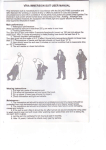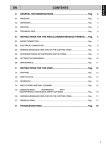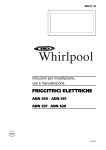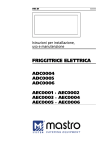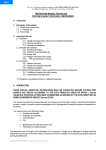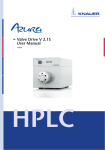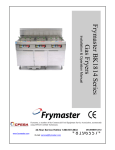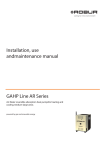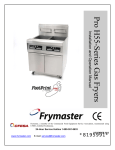Download GAS KITCHENS
Transcript
011_03 Instructions for installation, use and maintenance GAS KITCHENS K2F · K4F · K4FS · K6F · K8F K4FFE · K4FSFE · K6FFE · K8FFE K4FSFCE K4FSFCG K4FFG · K4FSFG · K6FFG · K8FFG K6FFGA B4F · B6F · B8F OP2F · OP4F · OP6F · OP8F © COPYRIGHT 2004 GIGA GRANDI CUCINE SRL 07/2009 CHARACTERISTICS Supplied by: Date: Customer Service: FAX e-mail 011_03 - GAS KITCHENS 07/2009 2 · 22 INDEX 1 Diagram 4 2 Features of the appliances 7 3 Technical data 7-8 4 Installation instructions 4.1 Safety rules 4.2 Structure, equipment and safety devices of the appliances 4.2.1 Cooking zone 4.2.2 Oven Gas version GN 2/1 and MAXI Gas version GN 1/1 ventilated Electric version GN 2/1 Electric version GN 1/1 ventilated 4.2.3 Neutral cabinet 4.3 Assembly 4.3.1 Installation premises 4.3.2 Statutory regulations and technical requirements 4.3.3 Installation 4.3.4 Installation operations 4.3.5 Gas connection 4.3.6 Smoke extraction 4.3.7 Electrical connection 4.3.8 Equipotential 9 9 9 9 9 9 9 9 9 9 9 9 10 10 10 10 10 10 10 5 Operation preparation 5.1 Preparation and Start-up 5.1.1 Start-up 5.1.2 Check of power 5.1.3 Checking the input pressure 5.1.4 Power check with volumetric method 5.1.5 Power check for operation with liquid gas 5.1.6 Check of pilot flame 5.1.7 Checking the primary air 5.1.8 Operation Control 5.1.9 Operator training 5.1.10 Conversion and adjustment 5.1.11 Replacement of burner nozzles 5.1.12 Setting reduced capacity power 5.1.13 Replacement of pilot nozzle (open flames) 5.1.14 Replacement of pilot nozzle (gas oven GN 2/1) 5.1.15 Replacement of pilot nozzle (gas oven MAXI) 5.1.16 Replacement of nozzle of gas ovens GN 1/1 and MAXI 5.1.17 Replacement of burner nozzle (gas oven) 5.2 Maintenance 5.3 Replacing parts 5.3.1 Gas valve (open flames) 5.3.2 Thermocouple (open flames) 5.3.3 Plug (gas oven) 5.3.4 Gas valve (gas oven) 5.3.5 Thermocouple (gas oven) 5.3.6 Main burner (gas oven) 5.3.7 Heating elements (electric oven GN 1/1) 5.3.8 Heating elements (electric oven GN 2/1) 5.3.9 Fan for electric and gas ovens GN 1/1 10 10 10 10 11 11 11 11 11 13 13 13 13 13 13 13 13 13 13 13 14 14 14 14 14 14 14 14 14 14 6 Instructions for use 6.1 Safety, cleaning and repair rules 14 14 6.2 Start-up 6.2.1 Lighting and disconnecting open flame burner 6.3 Lighting and shutting down a gas oven 6.3.1 Lighting the pilot (gas oven GN 1/1) 6.3.2 Lighting the pilot (gas oven GN 2/1 and MAXI) 6.3.3 Lighting the main burner and temperature adjustment (gas ovens GN 1/1) Shutdown 6.3.4 Lighting the main burner and temperature adjustment in gas oven GN 1/1 Shutdown 6.4 Lighting and shutdown of electric oven GN 1/1 6.5 Lighting and shutdown of electric oven GN 2/1 6.6 Turning the appliance off in case of breakdown 6.6.1 What to do in case of failure or prolonged period of disuse 6.7 Appliance care and frequency of maintenance 6.8 Recommendations for handling stainless steel industrial kitchens 6.8.1 Useful information on stainless steel 6.8.2 Warnings and advice for maintenance of stainless steel appliances 6.8.3 WEEE Directive 15 15 15 15 15 7 011_03 - GAS KITCHENS Appendix: Electrical diagrams 16 16 16 16 16 16 16 17 17 17 17 17 18 19-21 07/2009 3 · 22 1 - DIAGRAM 800 400 900 300 K4FFG K4FFE 970 3/4" K2F 3/4" 53 294 150 3/4" 21 21 53 53 100 150 21 53 694 52 706 K4F K4FFG - K4FFE K2F - OP2F 142 K4FS - K4FSFCG K4FSFG - K4FSFCE - K4FSFE 295 295 6.4 kW 900 590 6.4 kW 680 8.3 kW 295 8.3 kW 680 590 8.3 kW 590 350 350 350 3/4" 4.3 kW 8.3 kW 3/4" 255 310 200 4.3 kW 8.3 kW 3/4" 255 310 220 200 200 400 255 310 220 200 200 900 275 310 6.4 kW Ø 100 mm 200 400 B4F 4.3 kW Ø 80 mm 8.3 kW 6.4 kW 3/4" 8.3 kW 590 B4F 8.3 kW Ø 120 mm 350 900 3/4" 590 8.3 kW 3/4" 4.3 kW 275 3/4" 310 150 100 200 400 706 142 200 800 140 142 900 OP4F 295 340 OP4F 8.3 kW 350 900 8.3 kW 270 55 6.4 kW 53 694 53 35 4.3 kW 255 200 400 200 011_03 - GAS KITCHENS 07/2009 4 · 22 1 - DIAGRAM 1200 900 300 K6FFG K6FFE K6FFGA 970 3/4" 900 3/4" 150 21 100 150 21 53 1094 53 706 52 142 296 900 6.4 kW 680 6.4 kW 8.3 kW 590 350 4.3 kW 8.3 kW 4.3 kW B6F 3/4" 310 220 255 900 3/4" 3/4" 200 400 400 200 K6F K6FFG - K6FFE K6FFGA 150 100 706 142 1200 142 900 340 270 55 OP6F 53 1094 35 53 140 OP6F 4.3 kW 6.4 kW 8.3 kW 296 6.4 kW 6.4 kW 8.3 kW Ø 80 mm Ø 100 mm Ø 120 mm 350 900 4.3 kW 8.3 kW 4.3 kW 255 200 400 400 200 011_03 - GAS KITCHENS 07/2009 5 · 22 1 - DIAGRAM 1600 900 300 K8FFG K8FFE 970 900 3/4" 3/4" 21 150 100 150 21 53 1494 52 53 142 706 296 6.4 kW 680 6.4 kW 6.4 kW 8.3 kW 900 590 350 8.3 kW 4.3 kW 8.3 kW 4.3 kW 3/4" B8F 310 255 220 900 200 400 400 400 3/4" 200 3/4" K8F K8FFG - K8FFE 150 100 706 142 142 900 1600 340 270 55 OP8F 53 1494 53 35 140 OP8F 296 6.4 kW 6.4 kW 6.4 kW 8.3 kW 900 4.3 kW 6.4 kW 8.3 kW Ø 80 mm Ø 100 mm Ø 120 mm 350 8.3 kW 4.3 kW 8.3 kW 4.3 kW 255 200 400 400 400 200 011_03 - GAS KITCHENS 07/2009 6 · 22 2 - CHARACTERISTICS OF THE APPLIANCES These appliances are used for professional purposes. Installation, repair and use must be carried out by expert personnel. These instructions for installation are for our gas kitchens set up for the category in the table on page 8. The data plate is located on the front part of the appliance (on the control panel). CAT/KAT GAS/GAZ G30 G31 G20 II2H3B/P P mbar 30 30 20 - SE FI DK II2H3+ P mbar 30 37 20 - IT CH PT II2H3+ P mbar 28 37 20 - ES IE GB II2L3B/P P mbar 30 30 - 25 GB 0051 II2ELL3B/P G25 P mbar 50 50 20 20 DE TIPO/TYPE II2E+3+ P mbar 28 37 20 - FR BE MOD. II2H3B/P P mbar 50 50 20 - AT CH ART. I2E P mbar - - 20 - LU N. II2H3B/P P mbar 30 30 - - EE LV LT N. II2H3+ P mbar 28 37 20 - EE LV LT Qn kW MOD. I3B/P P mbar 30 30 - - NO MT CY I3+ P mbar 28 37 - - CY m3/h CZ SK SI GR IS HU Predisposto a gas: - Gas preset: - Prevu pour gaz: Eingestelt für Gas: - Preparado para gas: - Geschuckt voor: V AC KW Hz MADE IN ITALY THE APPLIANCE MUST BE CONNECTED IN COMPLIANCE WITH CURRENT REGULATIONS AND INSTALLED IN A WELL-VENTILATED ROOM. READ THE INSTRUCTION MANUAL BEFORE INSTALLING AND USING THE APPLIANCE. THE APPLIANCE MUST BE INSTALLED BY QUALIFIED PERSONNEL G30/G31 G20 30/37 mbar 20 mbar 3 - TECHNICAL DATA Model Version Dim.: LxWxH N. K2F 2 burners - open compartment 400 x 900 x 900/970 51BQ2899 OP2F 2 burners, embossed 400 x 900 x 270/340 51BQ2899 K4F • K4FS 4 burners - open compartment 800 x 900 x 900/970 51BQ2899 OP4F 4 burners, embossed 800 x 900 x 270/340 51BQ2899 K6F 6 burners - open compartment 1200 x 900 x 900/970 51BQ2899 OP6F 6 burners, embossed 1200 x 900 x 270/340 51BQ2899 K8F 8 burners - open compartment 1600 x 900 x 900/970 51BQ2899 OP8F 8 burners, embossed 1600 x 900 x 270/340 51BQ2899 K4FSFCG 4 burners - 1 gas oven GN 1/1 ventilated 800 x 900 x 900/970 51BQ2899 K4FFG • K4FSFG 4 burners - 1 gas oven GN 2/1 800 x 900 x 900/970 51BQ2899 K4FSFCE 4 burners - 1 electric oven GN 1/1 ventilated 800 x 900 x 900/970 51BQ2899 K4FFE • K4FSFE 4 burners - 1 electric oven GN 2/1 800 x 900 x 900/970 51BQ2899 K6FFG 6 burners - 1 gas oven GN 2/1 - cabinet 1200 x 900 x 900/970 51BQ2899 K6FFGA 6 burners - 1 gas oven MAXI 1200 x 900 x 900/970 51BQ2899 K6FFE 6 burners - 1 electric oven GN 2/1 - cabinet 1200 x 900 x 900/970 51BQ2899 K8FFG 8 burners - 2 gas oven GN 2/1 1600 x 900 x 900/970 51BQ2899 K8FFE 8 burners - 2 electric oven GN 2/1 1600 x 900 x 900/970 51BQ2899 B4F 4 burners - double controls - open compartment 800 x 900 x 900 51BQ2899 B6F 6 burners - double controls - open compartment 1200 x 900 x 900 51BQ2899 B8F 8 burners - double controls - open compartment 1600 x 900 x 900 51BQ2899 011_03 - GAS KITCHENS 07/2009 7 · 22 3 - TECHNICAL DATA TABLE 1 Model X Ø 80 Y Ø 100 Z Ø 120 Gas oven GN 1/1 Gas oven GN 2/1 Gas oven MAXI Category II2H3+ Construction type A Air necessary for combustion m3/h 9 15 17 7.5 16 26.5 Nominal thermal power kW 4.3 6.4 8.3 3.6 7.8 12.0 Minimum thermal power kW 1.2 1.8 2.9 0.75 - - Overall thermal power (gas) Hour consumption G20 m3/h G25 m3/h G30/G31 kg/h K2F • OP2F 11.2 kW 1,19 - 0,88 K4F • K4FFE • B4F • OP4F 28.3 kW 2,99 - 2,21 K6F • K6FFE • B6F • OP6F 39.5 kW 4,16 - 3,08 K8F • K8FFE • B8F • OP8F 54.7 kW 5,79 - 4,28 K4FFG 36.1 kW 3,81 - 2,82 K6FFG 47.3 kW 4,98 - 3,69 K8FFG 70.3 kW 7,44 - 5,50 K4FS • K4FSFE 34.2 kW 3,61 - 2,67 K4FSFG 42.0 kW 4,44 - 3,28 K4FSFCG 37.8 kW 3,99 - 2,95 K4FSFCE 34.2 kW 3,61 - 2,67 K6FFGA 51.5 kW 5,45 - 4,03 Connection pressure Methane gas 2H G20 20 mbar Liquid gas 3+ G30/G31 28/37 mbar Paramètres raccordement du gaz Methane gas 2H (HuB = 9.45 kWh/m3) in m3/h 0.455 0.677 0.878 0.421 0.825 1.375 Liquid gas 3+ (HuB = 12.87 kWh/kg) in kg/h 0.334 0.497 0.645 0.281 0.606 1.010 Nozzles Ø 1/100 mm G20 Main burner G30/31 Nominal thermal power 150 180 200 155 215 270 Minimal thermal capacity Adjustable Adjustable Adjustable Adjustable - - Nominal thermal power 100 120 140 100 140 170 Minimal thermal capacity 45 55 80 48 - - G20 35 35 35 - 35 35 G30/G31 20 20 20 - 20 20 Methane gas G20 5 4 10 Open 12 3 Liquid gas G30/G31 8 9 12 Open 10 Open No. of nozzles, pilot burner Primary air distance “A” Electrical data Electric oven power: Voltage: No. of cables per section: GN 2/1 - 5.9 kW V 400 3N 50 Hz / 230 3 50 Hz 5 x 2.5 mm2 / 4 x 2.5 mm2 GN 1/1 - 2.5 kW 230 50 Hz 3 x 1.5 mm2 011_03 - GAS KITCHENS 07/2009 8 · 22 4 - INSTALLATION INSTRUCTIONS 4.1 Safety regulations The smoke collector is in aluminised sheet metal and the protection grill is in enamelled cast iron. • Only a local gas utility technician is authorized to carry out gas installations and connections. The statutory regulations (applied in Germany VDE, Austria ÖVE, Switzerland SEV, etc.) and connection conditions performed by the gas utility must be strictly observed. • Connection to a power balance system for the installation in a wall is provided for through a connection point. Adhere to current local legal requirements for connection. • Please note the electrical diagram! Compare the wiring diagram number on the data plate of the appliance with the one shown on the electrical diagram. • Do not bend, crush or damage the cables against sharp corners. • Lay the cables so as to avoid contact with extremely hot surfaces. • The cable – which is totally sheathed – must be led inside the appliance through the cable clamp and cable raceway installed on the appliance. • Ventilation system installation can be carried only by expert personnel. • If the appliance is to be installed near walls, dividing walls, kitchen equipment or decorative panelling, these should be in non-inflammable material. If not, all appliances must be coated with thermalinsulation fireproof material. Make sure that all fire prevention standards and safety precautions are strictly adhered to. 4.2 Structure, equipment and safety devices of the unit Robust steel frame, with 4 height adjustable feet. 18/10 chrome-nickel steel outer panelling. Gas version GN 1/1 ventilated The tubular burners are in stainless steel and are resistant to thermal and mechanical stress. Gas is supplied through a safety valve with a thermostat and a safety thermocouple. The ignition of the main burner takes place by means of an AT transformer. The adjustment of the oven temperature, which can be varied between 160 and 300° C, is made with the thermostat. The bottom of the oven is made of stainless steel. The smoke collector is in aluminised sheet metal and the protection grill is in enamelled cast iron. Electric version GN 2/1 The heating elements are in the top (upper heat) and under the bottom (lower heat). Temperature adjustment between 50 and 300° C is made by a thermostat connected to a tri-polar switch. It is possible to turn on the upper and lower heating elements separately or at the same time. Indicator lights show when voltage is supplied to the appliance (see Fig. 4A). The cooking chamber is made of stainless steel. The upper heating elements are visible (grill), while the lower ones are covered by a sheet of stainless steel. Electric version GN 1/1 ventilated 4.2.1 Cooking zone • • • • • Burner with stabilized flame. Gas cocks with safety and adjustable from maximum to minimum. Thermoelectric ignition safety. Enamelled cast-iron pan supports. The bodies of the burners and the venturi tubes are made of cast iron, while the lid is brass • 18/10 chrome-nickel steel cooking top. • Knobs in thermosetting material. The heating elements are in the top (upper heat), under the bottom (lower heat), and in the rear around the fan (convection). The upper heating elements are visible (grill), while the lower ones are covered by stainless steel panels. Temperature adjustment between 50 and 300° C is made by a thermostat connected to a switch. The use of a 9-position commutator makes it possible to light the heating elements separately or at the same time with ventilation or in static mode. The lighting of the heating elements is indicated by 2 indicator lights (see fig. 4B). 4.2.3 Neutral cabinet 4.2.2 Oven The cooking chamber is made of stainless steel. The runners for the pans are made of steel or chromed rod iron. The pull-out grill is in chromed rod-iron. The door, with double wall and thermal insulation, is equipped with an insulated handle and a hinge with balanced spring. The insulation of the cooking chamber is fibreglass. Gas version GN 2/1 and MAXI The tubular burners are in chromed steel and are resistant to thermal and mechanical stress. Gas is supplied through a safety valve with a thermostat. The main burner is switched on from a pilot burner with a fixed nozzle. It is also equipped with a thermoelectric ignition safety with a thermocouple connected to the pilot burner. The burner has a piezo ignition. The adjustment of the oven temperature, which can be varied between 160 and 300° C, is made with the thermostat. The bottom of the oven, in cast iron with reinforced ribs (for GN 2/1) and steel (for MAXI), is in two pieces. In models K6FFG, K6FFE, a neutral cabinet with a door alongside the oven is standard. 4.3 Assembly 4.3.1 Installation premises The appliance should be installed in a well-ventilated room, and if possible under a range hood (check current regulations). The appliance can be installed on its own or with other similar equipment. If the appliance is to be installed near inflammable walls, a minimum distance of 150 mm around the sides and back should be allowed. If this distance cannot be obtained, take proper heat-protection action such as fitting tiles or thermal radiation protection material to the walls. Before connecting the appliance to the gas supply, check on the data plate that the appliance is suitable and type-tested for the type of gas available. If not, see paragraph “Conversion and adjustment”. 011_03 - GAS KITCHENS 07/2009 9 · 22 4 - INSTALLATION INSTRUCTIONS 4.3.2 Statutory regulations and technical requirements 4.3.6 Smoke extraction During installation of the appliance, the following regulations must be adhered to: • relevant legal directives; • Local building and combustion regulations; • "Technical rules for gas systems" worksheet; • "Technical rules for liquid gas" worksheet; • “Gas installations in industrial kitchens” worksheet; • Relative accident prevention standards; • Local gas utility regulations. • Local building and fire codes. These kitchens are type A appliances, thus no smoke extraction system is required. For the ventilation of the room where the appliance is installed, refer to related legislation. 4.3.3 Installation Assembly, installation and maintenance, i.e.: • assembly, gas connection, check of power, conversion or adaptation and start-up; Ask for approval from the local gas company. 4.3.4 Installation operations To level the appliance correctly, adjust the height of the feet. 4.3.5 Gas connection The R 3/4” gas connection of the appliance to the gas pipeline can either be permanently fixed to the mains or made detachable using an approved cock. If hoses are used, they must be in stainless steel and in compliance with the DIN 3383, part 1 or DIN 3384 regulations. After completing gas connection, check for leaks using a special leak-detector spray. 4.3.7 Electrical connection Before connecting the unit to the mains, check that: • The mains voltage corresponds to the values shown on the data plate; • The earth is in working order; • The power cord is suitable to the electrical input of the appliance (see table 1 on page 8). Also, up the line from the unit, there must be a device with contact opening of at least 3 mm which makes it possible to disconnect the appliance in omnipolar mode. To this end, for example, safety contactors may be used. The omnipolar switch must be located near the appliance and be readily accessible. The power cord must be approved and have a section which is suitable for the appliance. The cable must be at least type H07 RN-F. 4.3.8 Equipotential The appliance must be hooked up to a unipotential system. The required terminal is located near the cord inlet. It is marked by a tag with a symbol . 5 - SET-UP FOR OPERATION 5.1 Preparation and Start-up Before starting up the appliance, remove the protective wrapping. Then carefully clean the working surface and the external parts with lukewarm water and detergent, using a damp rag to remove all traces of anti-rust material applied in the factory, then dry with a clean cloth. 5.1.1 Start-up Before starting up the appliance, check that its specifications (category and type of gas used) match those of the family and group of the gas available locally. If not, it is necessary to adapt the appliance to the gas family or group required (see paragraph “Conversion and adjustment”). To start up the appliance, see the instructions for regular use. 5.1.2 Check of power The power may be: • the nominal power indicated on the data plate of the appliance; • the reduced capacity power. These nozzles are shown in table 1 “Technical data”. Nominal power is also obtained in respect of the supply pressure: • from 15 to 22.5 mbar for gases of the second family (G20/methane) • from 25 to 45 mbar for gases of the 3rd family (G30/propane, G31/butane) The appliance shall not be operated outside the above-mentioned pressure ranges. To adjust power with reduced capacity, use the data in table 1. If you wish to further check the nominal power, you may do so by using a gas meter according to the so-called "volumetric method". A simple inspection is usually enough to check if nozzles are functioning correctly. The appliances must be used with the specific nozzles for the nominal power. 011_03 - GAS KITCHENS 07/2009 10 · 22 5 - SET-UP FOR OPERATION Fig. 1 12 13 11 14 2 1 3 27 17 Bruciatori Burners X-Y X-Y 8 5 21 6 A 4 7 22 0 Bruciatore Burner Z Z 9 A 5.1.3 Checking the input pressure (Fig. 1) WARNING Input pressure should be measured using a fluid measuring gauge (e.g. a gooseneck pipe, min. resolution 0.1 mbar). Remove lock screw (22) from the pressure intake tube and connect the gauge hose: once measurement is complete, replace the screw (22). 5.1.4 Power check with volumetric method Using a gas meter and a stopwatch, you can read the volume of gas output per time unit. The correct volume corresponds to the value "E" expressed in litres/hour (l/h) or litre/minute (l/min). The following formula is used to calculate the value of “E”: Power E= Operating calorific value It is important measure the power when the appliance is in standby status. The calorific power value can be requested from the local gas company. The nominal power and the minimum power with respect to the nominal pressure are obtained by consulting the table for the adjustment of the gas passage (table 1). There is no pre-adjustment device for the nominal power. 5.1.5 Power check for operation with liquid gas Check if the type of nozzles used meet manufacturer requirements. Check that the pressure reducer installed in the system has an outlet pressure which is compliant with paragraph 5.1.2 "Check of power" (can be checked on the data plate of the appliance or by measuring the pressure). 5.1.6 Check of pilot flame For proper regulation, the pilot flame must surround the thermocouple and it must have a perfect appearance. Otherwise, adjust the air flow to the pilot. 5.1.7 Checking the primary air Both the oven and the open flames are equipped with primary air adjustment. Air volume flow is correct when there is sufficient protection against the flame rising when the burner is cold or in case of flashback when the burner is hot. 011_03 - GAS KITCHENS 07/2009 11 · 22 5 - SET-UP FOR OPERATION Fig. 2A 18 19 9 15 17 13 3 2 4 11 12 A 14 16 Fig. 2B 19 18 2 15 6 14 3 9 16 Fig. 2C 18 14 19 2 12 13 3 16 9 11 011_03 - GAS KITCHENS 07/2009 12 · 22 5 - SET-UP FOR OPERATION 5.1.8 Operation Control • Start the appliance in accordance with the instructions. • Check that the appliance does not have any leaks by using a leakdetecting spray. • Check ignition and that flame on the main burner lights properly and is correctly formed, even on low. • For oven GN 1/1 (fig. 3B), after lighting (para. 6.3.3), turn the knob to the minimum (spark) and check that the burner is lit along its entire length with flames at the lowest possible level. Adjustments can be made by turning screw (7). • Check that the pilot flames work properly. • Copy the set-up values on the data plate and place it in a suitable spot. • A servicing and maintenance contract is recommended. 5.1.9 Operator training • Instruct the user on the use of the unit and give him the relative user's manual. • Remind the user that any structural alterations or any building modification or renovation may affect the combustion air supply, thus requiring a second operation check. 5.1.10 Conversion and adjustment To change over form one kind of gas to another, for example from methane to liquid gas, or to another type of gas, the use of suitable nozzles for the main burner is required, in accordance with the table "TECHNICAL DATA". The nozzles of the main burners and pilot for different types of gas, marked with the relative diameter in hundredths of mm, are in an envelope which is provided with the appliance. After transformation or adaptation, carry out operating checks as described in paragraph 5.1.8, "Operation control." 5.1.11 Replacing burner nozzles (Fig. 1) To replace the nozzle (1): remove the grill, the burner cover, the burner body and the tray of the top. Then unscrew the screws (2) which fasten the primary air bushing and replace the nozzle (1). See the table "TECHNICAL DATA". Once the suitable nozzle has been installed, adjust the distance of the primary air and fasten the bushing with the appropriate screw. See the table "TECHNICAL DATA". 5.1.14 Replacement of pilot nozzle for gas oven GN 2/1 (Fig. 2A) Remove the front/lower panel by removing the fastening screws. Remove the closure (11). Use a screwdriver to unscrew and replace the nozzle (12) (see table, "TECHNICAL DATA"). When finished, replace the closing screw (11) and the relative seal (13). 5.1.15 Replacement of pilot nozzle for gas oven MAXI (Fig. 2C) After opening the oven door, remove the protection from the nozzle zone, remove the nut (11), slide out the bicone (13) and the injector (12). Replace the injector (12), see the table "TECHNICAL DATA", and replace all parts in reverse order. 5.1.16 Replacement of pilot nozzle for gas oven GN 2/1 (Fig. 2A) Remove the lower panel as previously described. Remove the fastening screw (2) of the primary air bushing (4) and push the bushing into the venturi tube. The nozzle (3) is now easily accessible. After substituting the nozzle based on the type of gas and the technical data, reassemble everything and adjust the distance "A" of the primary air. See the table "TECHNICAL DATA". 5.1.17 Replacement of nozzle of gas oven GN 1/1 (Fig. 2B) and gas oven MAXI (Fig. 2C) After opening the door, remove the grill, the grill supports and the stainless steel bottom, then unscrew the protection form the nozzle zone. Remove the air adjustment by unscrewing screw (2). The nozzle is now accessible. Replace it with one that is suitable for the type of gas to be used. See the table "TECHNICAL DATA". After replacement, reassemble everything and perform air adjustment (see the table "TECHNICAL DATA"). 5.2 Maintenance 5.1.12 Setting reduced capacity power (Fig. 1) The minimum setting screw (5) should be adjusted as follows: • for operation with LPG it should be screwed all the way down; • for operation with methane, use the gas flow table to check the value in l/min with respect to the operating calorific value (measurement in accordance with the volumetric method). Start the appliance in accordance with the instructions. Turn the knob to the minimum position and use screw (5) to adjust the flow (clockwise = flow reduction; counter-clockwise = flow increase). 5.1.13 Replacement of pilot nozzle, open flames (Fig. 1) Remove the grill and the tray of the top. Remove the plug (11) and use a screwdriver to unscrew and replace the nozzle (12). See the table "TECHNICAL DATA". Replace the closing screw (11) and the relative seal (13). Attention! Before doing any repair or maintenance work, unplug the appliance. The following maintenance program should be carried out at least once a year: • Check that all the safety and adjustment devices are working properly; • Check that the burners are working properly with regard to: - ignition; - combustion safety; Check functioning of the appliance as described in paragraph "Operation Control"; If it should be necessary to clean the open flame burners, proceed as follows: • Clean the grills, covers and bodies of the burners; • Clean the parts with water and detergent and an appropriate tool. Rinse and dry. When reassembling the parts, make sure you place them back in the right position. If it is necessary to clean the oven burner (18) (Fig. 2A/2B/2C), proceed as follows: • Loosen the screw (2), run the air adjustment into the venturi tube and remove it, unscrew the injector (3) and the nut or screw (9). • Unscrew the fastening screw (19) (Fig. 2A) of the burner and remove it; • Carefully clean all the holes of the burner with the aid of a tip of a suitable size; • Check that the smoke discharge is clear. • Reinstall everything in reverse order. 011_03 - GAS KITCHENS 07/2009 13 · 22 5 - SET-UP FOR OPERATION Fig. 3A Fig. 3B 3 2 6 3 6 2 4 1 5 5 2 3 4 AX M 1 7 23 4 5.3 Replacing parts 6 7 5 1 5 67 0 5.3.7 Heating elements for electric oven GN 2/1 (Fig. 4A) All parts must be replaced by authorized technicians only! To replace the following parts first remove all the control knobs and control panel (after loosening the fixing screws), then extract the ignition wire. 5.3.1 Open flame gas valve (Fig. 1 – Pos. 4) Loosen the fitting of the pipes (6) and (9) of the gas and of the thermocouple (8), loosen the fitting (7) for the fastening of the valve on the ramp and replace the piece. 5.3.2 Open flame thermocouple (Fig. 1 – Pos. 14) Loosen the nut (8) for fastening the thermocouple on the valve and on the burner (17) and replace the piece (14). 5.3.3 Plug of gas oven (Fig. 2A/2B - Pos. 6) Unscrew the fastening screws and remove the lower panel, extract the ignition wire and unscrew the screws (15). Insert a new plug. 5.3.4 Gas oven gas valve (Fig. 3A/3B) Loosen the fittings (1,2,3,4 in fig. 3A and 1,2,3 in fig. 3B) which are for the connection for the gas pipe and the thermocouple, remove the coil of the thermostat from its place in the cooking chamber and put in a new piece in the reverse sequence. 5.3.5 Gas oven thermocouple (Fig. 2A/2B/2C and 3) Unplug the appliance from the electrical mains! The lower heating element is placed under the bottom. The upper heating element is attached to the top of the cooking chamber. To remove the heating elements, loosen the screws that attach them to the corresponding flange, and pull the heating elements and relative wires forward. Use a screwdriver to disconnect the wires and install a new heating element in reverse order. 5.3.8 Heating elements for electric oven GN 1/1 (Fig. 4B) Unplug the appliance from the electrical mains! The lower heating element is placed under the bottom. The upper heating element is attached to the ceiling of the cooking chamber and the fan heating element is behind the back wall. To remove the heating elements, remove either the bottom and/or the rear wall, loosen the screws which fasten the heating element to the oven, and pull the heating element and relative wires forward. Disconnect the wires, and install a new heating element in reverse order. 5.3.9 Fan for electric and gas ovens GN 1/1 (Fig. 4B) To replace the fan, remove the fan cover rear wall. Remove the fan (1) by loosening the locking nut (2). Loosen the bolts (3) that hold the plate (4) which supports the motor (5) on the oven, pull the plate forward with the motor and relative wires, remove and re-install in reverse order. Unscrew the screws (15) and the nut (16) for fastening the thermocouple to the extension of thermocouple and insert the new piece. 5.3.6 Gas oven main burner (Fig. 2A) Unscrew the fastening screw (19) of the main burner and replace it with a new one. See also oven burner cleaning, para. 6.7). After any maintenance or repair work, replace the control panel and the lower panel. After replacing gas input components, check operation again and test for leakage. 011_03 - GAS KITCHENS 07/2009 14 · 22 6 - INSTRUCTIONS FOR USE 6.1 Safety, cleaning and repair rules • This appliance is used for the preparation of meals at industrial level. Usage and cleaning can be carried only by expert personnel. Maintenance and repair can be carried out only by skilled technical personnel. • These indications must be communicated to all those concerned during internal training. • Attention! This appliance must be constantly watched over when being used! • Grease and overheated oil can catch fire. Use this appliance only under constant control. Never use water to put out grease or oil! Cover with a lid, turn off the hot plate and remove pot from the burner. • Do not leave the burners running. • Do not overload the kitchen. For proper use, pots should not be bigger than the flames. • Parts of the appliance and attachments exposed to food must be cleaned with detergents and rinsed thoroughly with potable water. • Do not clean the appliance using water jets or steam, whether direct or pressurized! • If the room is being cleaned with water/steam jets or highpressure equipment, it is necessary to switch off the appliance first! • Before starting to clean the appliance, disconnect from the mains. • Do not use inflammable liquid to clean the appliance. changing its essential features. The manufacturer declines all responsibility for any non-compliance with the provisions contained in this manual. 6.2 Start-up 6.2.1 Lighting and shutting off open flame burner (Fig. 1) Turn the knob of the desired burner (21) to the spark position. Press all the way down and use a match or other suitable instrument to light the pilot burner. Hold the knob down for 15-20 seconds. If, when the knob is released, the pilot light goes out, repeat the operation. Then place the knob in the maximum or minimum position so that the main burner ignites. To shut off the burner, turn the knob to the right to the spark position, and the main burner will go out. To shut off the pilot light, place the knob in position (0). 6.3 Lighting and shutting of gas ovens (Fig. 3A/3B) 6.3.1 Lighting the pilot for gas ovens GN 2/1 and MAXI (Fig. 3A) Press the knob and turn it to the left until the spark position (5). Hold the knob down and at the same time press the piezo ignition button (6) repeatedly until the pilot comes on. Ignition of the pilot can be seen through the hole in the cooking chamber (with the door open). Hold the knob down for about 15-20 seconds. If, when the knob is released, the pilot light goes out, repeat the operation. • Repairs may be carried out only by skilled personnel. • During repairs, the appliance must undergo voltage omnipolar insulation (local switch, i.e. safety load cut-off switch). • Noise emission values of the appliance in operation are below 70dB (A). This value is compulsory according to certain national safety standards. WARNING Attention! The manufacturer declines all responsibility concerning mistakes included in these instructions due to translating or printing errors: the manufacturer also reserves the right to change the product as he see fits, though without 6.3.2 Lighting the main burner and temperature adjustment for gas ovens GN 2/1 and MAXI (Fig. 3A) To light the main burner, turn the knob further to the left until the desired temperature. The thermostat is marked in positions from 1 to 7. The approximate values for the temperature for each position are the following: Position Degrees °C 1 2 3 4 5 6 7 160 175 195 220 240 265 290 Fig. 4A 0 50 0 100 300 0 15 0 25 200 8 011_03 - GAS KITCHENS 6 7 9 07/2009 15 · 22 6 - INSTRUCTIONS FOR USE Fig. 4B 2 1 3 4 5 3 0 0 50 3 100 300 0 15 0 25 200 8 To shut off the main burner, turn the knob to the spark position. Only the pilot flame will remain lit. For complete shutdown, turn the knob to position (0); in this position the pilot burner also goes out. Turn on the switch located up the line from the unit. Press the knob and turn it to the left until the spark position (5). Hold the knob down and at the same time press the piezo ignition button (6) repeatedly. Hold the knob down for 15-20 seconds after the burner lights, which can be observed through the hole in the bottom of the cooking chamber (with the door open). 6.3.4 Lighting the main burner and temperature adjustment in gas oven GN 1/1 (Fig. 3B) To light the main burner, rotate the knob (5) to a position from 2 to MAX, considering that the temperatures which can be obtained are the following: Position Degrees °C 2 3 4 5 6 7 MAX 160 175 190 210 230 260 300 Shutdown To shut off the main burner, turn the knob to the spark position. Only the pilot flame will remain lit. For complete shutdown, turn the knob to position (0); in this position the pilot burner also goes out. 6.4 Lighting and shutting off electric oven GN 1/1 (Fig. 4B) Select the desired type of heating, turn the knob (6), keeping in mind that the indicator light (8) will remain on in all positions. This symbol corresponds to internal lights being on without any type of heating (optional). Heating takes place both from above (top heating element) and from below (bottom heating element). This is the traditional cooking function. The lower heating element is on (heating element in bottom). The heat thus flows from the bottom up. Heating takes place from the top down, since the upper heating element is on (heating element in top). 7 9 In this position the "grill" heating element is on, located in the upper part of the oven. As in the previous position with the fan on (convection). Shutdown 6.3.3 Lighting gas oven GN 1/1 (Fig. 3B) 6 In this position the top heating element (from above) and the bottom heating element (from below) are on, and at the same time the fan is in operation (convection). Convection cooking In this position, heat is produced by a circular heating element located on the back of the oven around the fan. Defrost function No heating element is on; only the fan operates in order to defrost frozen foods quickly. Turn the knob (7) to choose the desired temperature: indicator light (9) switches on and off with the operation of the heating elements. To turn off the oven, turn the to knobs to the zero position. 6.5 Lighting and shutting off electric oven GN 2/1 (Fig. 4A) Turn selector (6) right or left to choose the type of cooking, heat from above and/or below. In each of these positions, the green indicator light comes on (8 = voltage supplied to appliance). Turn the knob (7) to the desired position. The heating elements will come on. Indicator light (9) will come on when the desired temperature is reached and the heating elements switch off. To switch off the oven, turn the thermostat and the selector to the (0) position. 6.6 Turning the appliance off in case of breakdown In case of breakdown, shut down the appliance as instructed in the paragraph "Shutdown". In case of breakdown, close the connecting cock of the unit. Disconnect the appliance from the power mains. 011_03 - GAS KITCHENS 07/2009 16 · 22 6 - INSTRUCTIONS FOR USE 6.6.1 What to do in case of failure or prolonged period of disuse When the appliance is not to be used for a long time, clean thoroughly, close the gas cock and switch off any electric power. In case of malfunctioning or failure, close the gas cock. In case of malfunction, call the service centre. 6.7 Appliance care and frequency of maintenance Attention! When cleaning, carefully avoid washing the appliance with direct water jets or high-pressure water! Cleaning must be performed when the appliance is cold. Thorough daily cleaning of the appliance, after disconnecting it, will keep it in perfect working order and make it last longer. All steel parts should be cleaned with water and a detergent, using a damp cloth; do not use abrasive substances or corroding detergents. Do not use steel wool, which could cause rust to form. For the same reason, avoid touching the appliance with anything made of iron. Do not clean with sandpaper and lubricating gel paper. If absolutely necessary, you may use pumice powder. If the appliance is extremely dirty, use a synthetic sponge (i.e. Scotchbrite sponge). After cleaning the appliance, rinse with clean water and wipe with a clean cloth. If the main burner needs cleaning, proceed as follows: • Remove the pan support, cover, rings and burner crown; • Clean burner parts with water, soap and a suitable tool, then rinse and wipe; • When reassembling the parts, make sure you place them back in the right position. All maintenance and repair work must be carried out by authorized technicians only. Never clean the appliance with water jets or high-pressure water! The appliance must be checked at least once a year. For this reason, a service agreement contract is recommended. 6.8 Recommendations for the treatment of stainless steel industrial kitchens 6.8.1 Useful information on stainless steel Industrial kitchens are generally made of stainless steel having the following material codes: • 1.4016 or 1.4511 = magnetizable chromed steels • 1.4301, 1.4401 and 1.4571 = non-magnetizable chromed steels Chromed steels have favourable thermo-technical characteristics. In fact, they have less of a tendency to warp due to the effect of heat. Chrome-nickel steels, instead, have good corrosion resistance features. Stainless steel corrosion resistance is given by an inactive coat that builds up on the surface by coming into contact with oxygen. The oxygen in the air is already enough to build up the inactive coat that allows automatic removal of anomalies and damage due to mechanical actions. The inactive coat builds up or re-builds up faster if the steel comes in contact with running water containing oxygen. A more powerful effect is given by oxidative acids (nitric acid, oxalic acid). These acids are used if the steel has undergone strong chemical stresses, hence generally losing its inactive coat. The inactive layer can be chemically damaged or jeopardized by reducing agents (oxygen consumption) if they come in contact with the steel, concentrated or at high temperatures. These active substances include for instance: • saline and sulphurous substances • chlorides (salts) • concentrated spices such as mustard, vinegar essences, soup cubes, kitchen salt solutions, etc. More damage can be caused by: • outside rust (i.e. from other components, tools or incipient rust) • iron particles (i.e. file dust) • contact with non-ferrous metals (element build up) • lack of oxygen (i.e. no air inlet, water lacking oxygen). 6.8.2 Warnings and advice for maintenance of stainless steel appliances • Stainless steel equipment surfaces must be kept clean and in contact with air at all times. When not running, keep appliance doors open so as to allow air to run through it. • Regularly remove calcium , grease, starch, and egg white deposits where rust may build up if there is lack of air. Do not use bleaching products or products containing chloride. Follow all indications given by the company concerning special soaps and cleaning methods to be used for the appliance. If no specific cleaning recommendations are available, it is necessary, however, to use detergents having a low chloride content. After cleaning, remove all soap residues with plenty of clean water and thoroughly dry the surfaces. • Minimize contact of stainless steel with concentrated acids, spices, salts, etc. Even acid vapours coming from cleaning the tiles favour stainless steel corrosion. • Particularly for pots and multiple appliances, it is not recommended to load the cooking chamber only with food having a high salt content. It is preferable to cook different food together, i.e. fatty dishes or vegetables containing acids. • Avoid damaging the stainless steel surface, in particular with different metals. Residues from other metals help build up the formation of chemical microelements that may cause rust. At any rate, it is appropriate to avoid contact between iron and steel since it produces rust. Any contact between stainless steel and iron (steel wool, pipeline chips, chalybeate waters) can start corrosion phenomena. As for mechanical cleaning, it is recommended to use only steel wool or natural, plastic or steel bristle brushes. Steel wool or brushes with stainless steel can cause rust due to rubbing. Newly formed rust spots can be removed with slightly abrasive liquid soaps or fine-grained sand paper. Larger rust spots can be removed with 2-3% of hot oxalic acid solution. If these cleaning products do not do the job, a nitric acid (10%) treatment is required. Attention! These treatments can be carried out only by expert personnel according to current regulations. 011_03 - GAS KITCHENS 07/2009 17 · 22 6 - INSTRUCTIONS FOR USE 6.8.3 The 2002/96/EC (WEEE) Directive: information to users This informational note is meant only for owners of equipment marked with the symbol shown in Fig. A on the adhesive label featuring the technical specifications applied on the actual product (the label also giving the serial number). This symbol indicates that the product is classified, according to the regulations in force, as an item of electrical and electronic equipment and conforms to EU Directive 2002/96/EC (WEEE) meaning that, at the end of its service life, it must be treated separately from domestic waste, i.e. it must be handed in free of charge to a separate waste electrical and electronic equipment collection centre or returned to the reseller when buying a new equivalent item of equipment. The user is responsible for delivering the unit at the end of its life to the appropriate collection facilities. Failure to do so shall result in the user being subject to the penalties prescribed by the legislation in force on waste. Suitable separated collection so that the unit no longer used can be sent off for environmentally compatible recycling, treatment and disposal helps avoid possible negative effects on the environment and on health and facilitates the recycling of the product's component materials. For more detailed information on available collection systems, contact the local waste disposal service or the shop you purchased the unit from. Producers and importers fulfil their responsibility for environmentally compatible recycling, treatment and disposal both directly and by joining a collective scheme. NOTES 011_03 - GAS KITCHENS 07/2009 18 · 22 7 - APPENDIX: ELECTRICAL DIAGRAMS K4FSFCE R T C P1 2 1 1 P2 2 P3 3 P4 4 G P5 5 P6 6 P7 7 P8 8 RC RG ~ MV RV RS L N A 9 8 7 6 5 4 3 2 1 0 B1 8 7 6 5 4 3 2 1 P8 P7 P6 P5 P4 P3 P2 P1 A C R G RC Terminal board Commutator Green indicator light Yellow indicator light Top heating element 011_03 - GAS KITCHENS RG RS RV MV T Grill heating element Bottom heating element Fan heating element Motorized fan Thermostat 07/2009 19 · 22 7 - APPENDIX: ELECTRICAL DIAGRAMS K4FFE - K4FSFE - K6FFE - K8FFE H1 1 H2 2 3 4 5 6 R1 5 6 2 7 1 3 R2 4 1 B2 P3 P4 P6 2 3 4 5 6 P2 P5 1 2 3 4 B1 mA L1 L 2 L 3 N F2 F1 P1 P2 P3 P4 PE 400 V 3N ~ 8.48 A 1 2 3 4 R1/R2 mA 1 2 3 4 5 6 1 2 3 4 5 6 L1 L 2 L 3 230 V 3 ~ 14.75 A 3 2 1 1 0 B2 2 L1 5 6 7 P3 P4 P5 2 1 P6 3 3 4 mA R1/R2 N 4 P2 230 V ~ 25.7 A Connected power: 5.9 kW 230/400 mA Terminal H1 Indicator light (power) B1 Switch H2 Indicator light (heating) B2 Selector R1-2 Oven heating element F1 Thermostat F2 Temperature limiter 011_03 - GAS KITCHENS 07/2009 20 · 22 7 - APPENDIX: ELECTRICAL DIAGRAMS K4FFE 4 - K4FSFE 4 - K6FFE 4 - K8FFE 4 PE 1 2 3 4 R1/R2 mA 1 2 3 4 5 6 1 2 3 4 5 6 L1 L 2 L 3 230 V 3 ~ 14.75 A mA B1 F1 F2 H1 H2 R1 R2 Terminal board Switch Thermostat Temperature limiter Green indicator light Orange indicator light Upper heating elements Lower heating elements 3 2 1 1 0 B2 2 L1 5 6 7 P3 P4 P5 2 1 P6 3 3 4 mA R1/R2 N 4 P2 230 V ~ 25.7 A K4FSFCG PE mA B1 MV H2 011_03 - GAS KITCHENS Terminal board Fan switch Motorized fan Indicator light 07/2009 21 · 22 WARNING THE MANUFACTURER CANNOT BE HELD RESPONSIBLE FOR ANY INACCURACIES IN THIS BOOKLET DUE TO COPYING OR PRINTING ERRORS. DUE TO ITS POLICY OF CONTINUAL PRODUCT IMPROVEMENT, THE MANUFACTURER RESERVES THE RIGHT TO MAKE ANY CHANGES DEEMED NECESSARY. THE MANUFACTURER CANNOT BE HELD RESPONSIBLE IF THE INSTRUCTIONS CONTAINED IN THIS MANUAL ARE NOT OBSERVED. GIGA GRANDI CUCINE S.r.l. - Via Pisana, 336 - Loc. Olmo - 50018 SCANDICCI (FI) - ITALY Tel. +39 055 722 33 (11 linee r.a.) - Fax +39 055 7310 056 - www.gigagrandicucine.it [email protected]
























